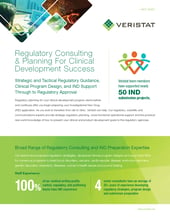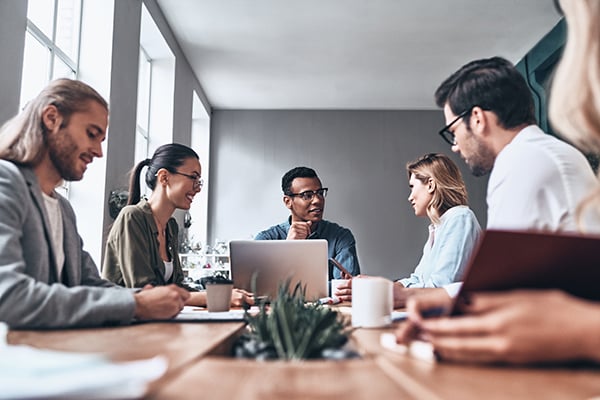Regulatory Considerations for Biosimilars Development in the U.S.
ART PODCAST | SEASON 3 | EPISODE 6
In this episode of Advancing Revolutionary Therapies, Kevin Hennegan, Director of North American Regulatory Affairs at Veristat, talks to Ellen Truitt and Erin Flynn, both of whom are Regulatory Strategists at Veristat, about key regulatory considerations for biosimilar development in the U.S.
Check out the full episode to learn more or read the summary below.
What is a Biosimilar?
The development of biosimilar products in the U.S. has been progressing since the regulatory pathway was established as part of the Affordable Care Act. At the time of this recording, the FDA has approved 39 biosimilar products, and the number of active biosimilar development programs has been climbing steadily. The market for these products has been projected by some to exceed $100 billion dollars by 2028.
Kevin: Can you explain what is a biosimilar and how does this compare to generic drugs?
Erin Flynn: You can’t talk about biosimilars without first talking about generics. Generics are identical copies of approved small molecules, which are more easily characterized and can be identically synthesized.
A biosimilar, in contrast, is a proposed biologic that is “highly similar” to an approved biologic. Biologics are large, complex molecules that are manufactured in living systems like CHO cells. They have inherent variations in structural components between batches, mainly due to post-translational modifications in the living system. Thus, instead of being an identical copy, biosimilars must prove through extensive analysis that they are highly similar to the reference product.
Demonstrating Biosimilarity to a Reference Product
Kevin: How do you demonstrate that a biosimilar is “highly similar” to a reference product?
Erin Flynn: The FDA recommends a stepwise approach to demonstrating biosimilarity, with the foundation being your structural and functional analytical similarity exercises. Sponsors of biosimilars must conduct extensive in vivo and in vitro analyses with both the proposed biosimilar and sourced lots of the reference product, head-to-head. These analyses evaluate critical quality attributes that define the pharmacologic activity, potency, and purity of the proposed biosimilar and the reference product.
Ellen Truitt: Sponsors must also consider the role of animal data in assessing the toxicity and immunogenicity of the biosimilar. Nonclinical studies are not always required for a biosimilar program; however, the degree to which your analytical similarity exercises demonstrate biosimilarity will inform you as to what may be required. If the analytical similarity data are strong, it may be possible to justify limited, non-sacrificial toxicology studies. Again, any nonclinical studies should evaluate the biosimilar and the reference product head-to-head.
Kevin: While some nonclinical studies may not be explicitly required for biosimilars, would you say they are advisable prior to conducting human clinical trials?
Ellen Truitt: Yes. The sponsor will still want to demonstrate to the FDA that they have done enough work to de-risk and justify human studies.
Erin Flynn: Finally, the FDA expects biosimilar sponsors to conduct a comparative pharmacokinetic, pharmacodynamic, and immunogenicity study of the biosimilar and the reference product, head-to head.
Studies Needed to Demonstrate Biosimilarity:
-
Structural and functional analytical characterization
-
Nonclinical evaluation
-
Human pharmacokinetic (PK) and pharmacodynamic (PD) data
-
Clinical immunogenicity data
-
Comparative clinical studies of the proposed product and the reference product
Differences Between Regular and Interchangeable Biosimilars
Kevin: Biosimilar products can have an additional designation of being “interchangeable”. What is the difference between a regular biosimilar and an interchangeable product?
Ellen Truitt: An interchangeable product is a biosimilar that meets additional, more rigorous requirements. In addition to the biosimilarity exercises required for a typical biosimilar, an interchangeable biosimilar is expected to demonstrate that the proposed product will produce the same clinical results as the reference product in any given patient, and that for a product that is administered more than once, switching between the reference product and interchangeable biosimilar does not increase safety risks or decrease efficacy.
This is typically demonstrated by conducting a comparative clinical efficacy study, with crossovers performed between the reference product and proposed biosimilar product. The FDA has described a type of study which is recommended for demonstrating interchangeability, where one arm receives treatment with the reference product throughout the study, and another arm crosses over between the reference product, the proposed biosimilar, and then back to the reference product through the same treatment period.
Erin Flynn: In addition, there are differences in the way biosimilars and interchangeable biosimilars are prescribed. A biosimilar product must be specifically prescribed by a health care provider, while an interchangeable can be swapped with a reference product at the pharmacy, without notifying the prescriber, much like generics.
Evaluating Comparative Data Between a Biosimilar and Reference Product
Kevin: How much variability is allowed between a reference product and the proposed biosimilar from an analytical and clinical perspective?
Erin Flynn: From the analytical perspective, it is a very complicated picture. The allowable variance margins depend on the critical quality attribute (CQA) being assessed, and these CQAs are ranked in three tiers as to their criticality and potential for clinical impact.
- For Tier 1 CQAs, like amino acid sequence, protein concentration, and potency, it needs to be nearly equivalent between the biosimilar and the reference product. Tier 1 CQAs are the most rigid and the expected equivalence margin is +/- 1.5 standard deviation (SD) from the mean with a 90% confidence interval.
- For Tier 2 CQAs, like higher order structure and oxidized variants, there is some potential for clinical impact but less so than Tier 1. The variance margin expected is +/- 3.0 SD from the mean with a 90% confidence interval.
- For Tier 3 CQAs, like truncated variants, side by side comparisons are still necessary, but if they have no impact clinically, it is perfectly acceptable to have differences between the biosimilar and the reference product. Still, this means that Tier 3 CQAs must have strong scientific justification for a lack of impact on clinical outcomes.
Ellen Truitt: From a clinical perspective, the pharmacological parameters evaluated should be within 80-125% of that observed with the biological reference product. With respect to immunogenicity parameters, such as the formation of anti-drug and neutralizing antibodies, the FDA has granted approval to products where the 95% confidence interval was within 10%.
Kevin: How many batches need to be evaluated with these parameters to demonstrate biosimilarity?
Erin Flynn: FDA guidance on Biosimilars recommends that at least 10 batches of the reference product and at least 6-10 batches of the biosimilar product should be used; but often times, many more batches are used to meet the confidence interval expected for the analytical similarity exercises.
Kevin: What’s the largest number of batches you’ve seen?
Erin Flynn: I’ve seen upwards of 80 batches of reference product used to support biosimilarity.
Kevin: What happens if the proposed biosimilar product is better than the reference drug?
Ellen Truitt: You can’t be approved as a biosimilar if you are superior to the reference product. You must be neither inferior nor superior to the reference product to be considered a biosimilar. In the case where a sponsor’s proposed biosimilar demonstrates superiority, they would submit a standard 351(a) BLA and would need to support that BLA with the level of data which is expected for new products or entities.
Kevin: For small molecule drugs, sponsors are allowed to rely on the FDA’s findings of safety and efficacy to skip evaluation of certain risks. Is this approach permitted under the biosimilars pathway?
Ellen Truitt: Yes, but for only some types of studies. For example, safety pharmacology, reproductive and developmental toxicity, carcinogenicity studies, and human QT/QTc studies generally do not need to be conducted for the biosimilar candidate, provided that analytical similarity has been well-established.
Kevin: Are there any variations to the product that are acceptable for a biosimilar?
Erin Flynn: Minor differences between the biosimilar and the reference product are acceptable, as long as there are no clinically meaningful differences. Minor differences can include glycosylation patterns, truncated N- or C-terminals, folding patterns, or even the final formulation of the drug. Overall, there should be no impact to clinical safety or efficacy.
Kevin: Considering sponsors don’t have access to the innovator’s potency assay, what do you recommend they consider when developing their own potency assay to establish similarity to a biological reference drug?
Erin Flynn: Biosimilar developers do need to develop their own potency assay and compare the assay results directly between their product and the reference drug. You may be able to get some hints about the type of potency assay used for the reference product through published information, including FDA review documents, but more importantly, the assays you choose to develop should be functional assays and should be relevant to the product’s mechanism of action (MOA).
Financial Considerations for Biosimilar Development
Kevin: How much does the biosimilars pathway reduce overall development cost and program timeline?
Ellen Truitt: It can be very expensive to develop and manufacture biologics under any circumstance. A typical biosimilar will take 6-9 years to develop and will still cost upwards of $100M or more. In comparison, an original biologic will take some 10-12 years and cost in the hundreds of millions. So, a sponsor would save some cost and time in the development of a biosimilar since there is a lessened emphasis on robust clinical efficacy data, and there would be less time spent conducting Phase 1 and 2 studies. However, the amount of data required for the 351(k) BLA submission for a biosimilar is still quite large in comparison to what would be included in an ANDA – so a sponsor cannot expect to save as significant of an amount of time or money like they might for a generic small molecule.
Erin Flynn: The true financial benefit for a biosimilar product development is upon arrival to market, especially if you're the first biosimilar to a particular reference biologic.
Only the first approved biosimilar for a particular biologic can obtain market exclusivity which is granted for one year starting at the date of commercial product launch.
Kevin: Another important set of financial considerations for biosimilars development are the user fees, which unlike innovator products, are assessed while the product is still in development. How much are those user fees currently, and when are they triggered?
Erin: There is an initial and annual user fee for sponsors of biosimilar products. The initial biosimilar product development fee is due when the sponsor submits an IND application or within 7 days after FDA grants the first biosimilar product development meeting, or BPD meeting, whichever comes first. Once a sponsor has paid the initial user fee, the annual fee is assessed for the product each fiscal year that the biosimilar program is active.
Ellen: And these fees are laid out in the Biosimilars User Fee Act (BsUFA), which gives the FDA authority to assess and collect user fees. The current fiscal year’s initial and annual fee is $47,325, which will remain in effect until September 23, 2023. Each year FDA reassesses the statutory fee and adjusts for inflation and other factors.
Kevin: Biosimilar product development meetings are a little different from the Type A, B, C, and D meetings. Can you summarize the types of meetings that are available to biosimilar programs, and their basic parameters?

Ensure a Successful Regulatory Agency Meeting to Reduce Development Costs and Time to Approval
Erin: There are 5 types of BsUFA meetings for biosimilar products. There is the biosimilar initial advisory meeting, or BIA meeting, and then BPD Type 1, BPD Type 2, BPD Type 3, and BPD Type 4 meetings.
- The BIA meeting is similar to a pre-IND meeting and is used to assess the feasibility of the biosimilar 351(k) pathway. The FDA expects data from at least one lot of biosimilar and reference product tested but extensive analysis is not conducted at this meeting.
- A BPD Type 1 meeting is analogous to a PDUFA Type A meeting for stalled programs.
- A BPD Type 2 meeting is analogous to a PDUFA Type C meeting to discuss any specific issues in an ongoing program.
- A BPD Type 3 meeting is unique to BsUFA and is an in-depth review of all analytical similarity data, with a preliminary evaluation of the analytical similarity exercise performed by the FDA.
- Finally, a BPD Type 4 meeting is analogous to a pre-NDA or pre-BLA PDUFA meeting.
Note, the BIA meeting does not incur the initial biosimilar product development fee, but any other BPD Type meeting does. In addition, one thing unique to all BsUFA programs is that the meeting request and meeting package must be submitted at the same time for the FDA to approve a meeting. This is unlike most PDUFA meetings, where the meeting package is submitted up to 50 days after submission of the meeting request.











